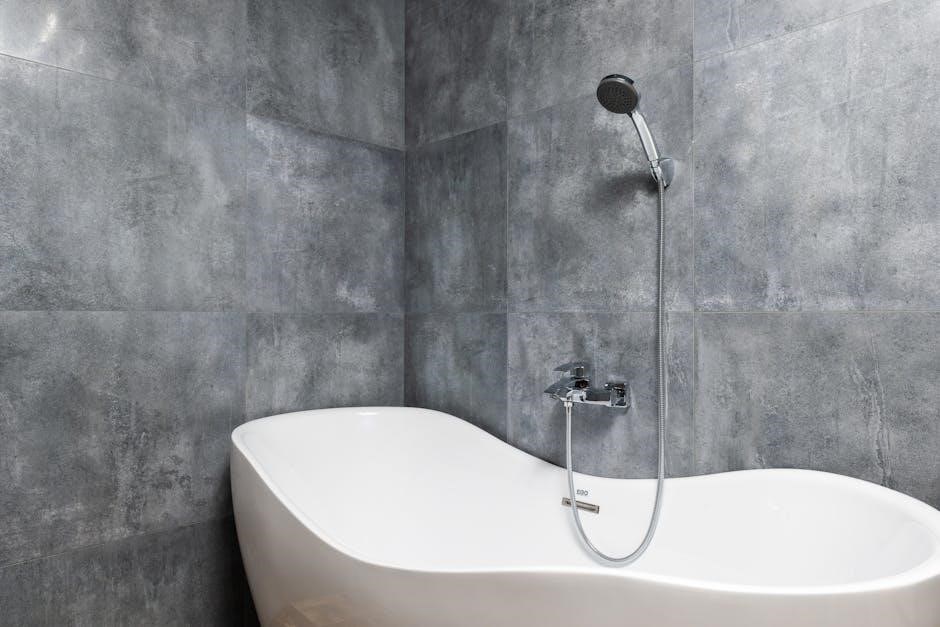
billi tap fault codes pdf
Billi Tap fault codes are essential diagnostic tools that help identify system issues. Understanding these codes ensures efficient troubleshooting and maintenance‚ keeping your tap functioning optimally.
Overview of Billi Tap Systems

Billi Tap systems are advanced water dispensing solutions designed for residential and commercial use‚ offering boiling‚ chilled‚ and sparkling water options. These systems integrate cutting-edge technology‚ including the EcoIntelligence self-learning timer‚ which adapts to user behavior to optimize energy efficiency. The Billi B-5000 series‚ for example‚ features a dual-stage filtration system‚ ensuring clean and safe drinking water. With sleek designs and user-friendly interfaces‚ Billi Taps are known for their reliability and innovative features. Regular maintenance‚ such as filter replacements‚ is crucial for maintaining optimal performance. The system’s ability to self-diagnose faults and display error codes makes troubleshooting easier‚ ensuring minimal downtime. Understanding these systems is key to maximizing their efficiency and longevity.
Importance of Understanding Fault Codes
Understanding Billi Tap fault codes is crucial for maintaining optimal system performance and addressing issues promptly. Fault codes provide clear indicators of system malfunctions‚ such as filter replacements or internal errors. Ignoring these codes can lead to reduced efficiency‚ costly repairs‚ or even complete system breakdowns. By deciphering these codes‚ users can identify the root cause of problems‚ enabling timely resolutions. For instance‚ a flashing red light often signals a filter replacement‚ while green lights may indicate system status updates. Familiarity with these codes empowers users to troubleshoot minor issues independently‚ reducing reliance on professional assistance. Regular monitoring and interpretation of fault codes ensure prolonged system longevity and consistent water quality‚ making it essential for all Billi Tap users to grasp their meaning and significance.
Accessing Billi Tap Fault Codes PDF
The Billi Tap fault codes PDF is available on the official Billi website‚ providing a comprehensive guide to diagnostic codes and troubleshooting steps for optimal system maintenance.
Downloading the Fault Codes Guide
To download the Billi Tap fault codes guide‚ visit the official Billi website and navigate to the support or resources section. Look for the “Fault Codes PDF” or similar option. Ensure you select the correct model to match your specific Billi Tap system. Once located‚ click the download link to access the PDF. Save it to your device for easy reference. The guide typically includes detailed explanations of error codes‚ troubleshooting steps‚ and maintenance tips.
For older models‚ you may need to contact Billi customer support directly to obtain the document. Always verify the source to ensure you’re downloading the official guide.
Navigating the PDF Document
The Billi Tap fault codes PDF is designed for easy navigation‚ typically featuring a clear table of contents. Users can quickly locate specific fault codes by referencing the index or using the search function in their PDF viewer. The document is usually organized by error type‚ with dedicated sections for common issues like temperature errors or flow rate problems. Each fault code is accompanied by a description‚ possible causes‚ and recommended solutions. Visual aids‚ such as diagrams or charts‚ may also be included to simplify troubleshooting. Familiarize yourself with the layout to efficiently diagnose and resolve issues. Regular updates ensure the guide stays relevant to current models and firmware.

Understanding Common Billi Tap Fault Codes
Identifying and interpreting common fault codes is essential for diagnosing issues quickly. Each code corresponds to specific system malfunctions‚ guiding users to potential causes and solutions efficiently.
Interpreting Flashing Light Indicators
Flashing light indicators on Billi Taps are crucial for identifying system status and faults. Each color corresponds to specific conditions‚ such as red for errors or green for normal operation. The pattern and speed of flashes provide additional clues about the issue. For example‚ a rapidly flashing red light may indicate a critical system failure‚ while a slow green flash signals standby mode. Referencing the Billi Tap fault codes PDF ensures accurate interpretation‚ as it outlines the meaning of each light pattern. Understanding these indicators allows users to address issues promptly‚ whether it’s a simple reset or a more complex repair. Regular monitoring of these lights helps prevent minor problems from escalating. Always consult the guide for precise diagnostics;
Decoding Error Messages and Symbols
Billi Tap systems display error messages and symbols to indicate specific issues‚ which are detailed in the fault codes PDF. These messages may appear as alphanumeric codes‚ symbols‚ or combinations of both on the tap’s display or in the system’s interface. Each code corresponds to a particular fault‚ such as a temperature sensor malfunction or low water flow. The PDF guide provides a comprehensive list of codes‚ their meanings‚ and potential solutions. Users can cross-reference the codes with the guide to diagnose problems accurately. Regularly updating the system and ensuring the latest firmware can prevent unclear error messages. By understanding these codes‚ users can address issues promptly‚ minimizing downtime and maintaining optimal performance. Always refer to the official Billi Tap fault codes PDF for accurate interpretations.

Troubleshooting Tips for Billi Tap Issues
Start by checking power supply and water connections. Refer to the fault codes PDF for specific guidance. Reset the system if indicated‚ and clean or replace filters. Contact a professional if issues persist.
Step-by-Step Diagnostic Procedures
To diagnose Billi Tap issues‚ start by consulting the fault codes PDF for specific error interpretations. Begin with a power cycle: turn off the tap‚ wait 30 seconds‚ and restart it.
Check the water supply lines for leaks or blockages. Ensure filters are clean and not clogged‚ as dirty filters often trigger alerts.
If error codes persist‚ reset the system by holding the reset button for 5 seconds. Use the PDF guide to identify the exact fault code and follow recommended fixes.
Inspect for physical obstructions in the tap or pipes. Record the error code and any symptoms for reference when seeking professional help if needed.
Resetting the Billi Tap System
Resetting your Billi Tap system can resolve minor issues without advanced troubleshooting. Start by switching off the tap and ensuring the power is off at the mains for 10 seconds.
Locate the small reset button‚ usually found under the tap or near the control panel. Press and hold it for 3-5 seconds until the LED lights flash twice.
Release the button and turn the power back on. The system will reset to its default settings‚ clearing minor glitches.
Note that resetting does not erase custom settings like temperature preferences. If issues persist‚ consult the fault codes PDF for further guidance.

Common Fault Codes and Their Solutions
Identify and resolve issues quickly with the Billi Tap fault codes guide. Common errors include filter alerts‚ temperature faults‚ and system resets. Find solutions in the PDF manual.
Red Flashing Light: Filter Replacement
A red flashing light on your Billi Tap indicates a filter-related issue. This could mean the filter is clogged‚ expired‚ or improperly installed. To resolve this‚ switch off the power‚ locate the filter‚ and replace it with a genuine Billi Tap filter. Ensure the new filter is correctly seated and aligned. After replacement‚ reset the system by turning it on and off. The light should stop flashing if the issue is resolved. Regular filter replacements are essential to maintain water quality and system performance. Refer to the Billi Tap fault codes PDF for specific guidance tailored to your model. Always use compatible filters to avoid further complications.
Green Flashing Lights: System Status Indicators
Green flashing lights on your Billi Tap indicate the system is operational and functioning correctly. These lights often signal specific statuses‚ such as heating‚ cooling‚ or standby modes. A steady green light typically confirms the system is ready for use. Flashing patterns may vary‚ so consult the Billi Tap fault codes PDF for precise interpretations; If the green light flashes but the tap isn’t responding‚ it could be in sleep mode or undergoing a self-test. To troubleshoot‚ ensure the system is powered on and check for any obstructions. Resetting the tap by switching it off and on may resolve minor issues. Always refer to the official guide for model-specific guidance to ensure optimal performance and reliability.

Maintenance and Prevention Tips
Regular maintenance ensures optimal Billi Tap performance and prevents faults. Descaling‚ filter replacements‚ and cleaning are essential. Check for leaks and consider water softener installation to minimize limescale buildup. Schedule annual professional servicing for thorough system checks and part replacements to maintain efficiency and longevity.
Regular Filter Changes and Cleaning
Regular filter changes and cleaning are crucial for maintaining optimal performance and preventing faults in your Billi Tap system. Over time‚ filters accumulate impurities‚ which can reduce water flow and quality. Replace filters every 6 to 12 months‚ depending on usage and water quality. Cleaning filters gently with a soft brush or cloth can extend their lifespan. Always use genuine Billi replacement filters to ensure compatibility and efficiency. Neglecting filter maintenance can lead to system slowdowns‚ increased energy consumption‚ or even fault code activations. By prioritizing filter care‚ you can prevent common issues and keep your Billi Tap running smoothly and efficiently for years.
Scheduling Routine Maintenance
Scheduling routine maintenance is essential for ensuring your Billi Tap system operates efficiently and reliably. Regular checks help identify potential issues before they escalate‚ reducing the likelihood of fault codes appearing. Maintenance tasks include inspecting water pressure‚ flow rates‚ and pipe connections‚ as well as ensuring all components are clean and functioning properly. It is recommended to schedule professional maintenance every 6 to 12 months‚ depending on usage. This proactive approach not only prevents unexpected breakdowns but also extends the lifespan of your Billi Tap. By staying on top of maintenance‚ you can enjoy optimal performance‚ reduced fault code occurrences‚ and consistent water quality. Always refer to your user manual for specific maintenance recommendations tailored to your system.

Advanced Troubleshooting Techniques
Advanced troubleshooting involves analyzing system performance metrics and utilizing specialized diagnostic tools to identify complex issues. Refer to the Billi Tap fault codes PDF for detailed guidance.
Using the Self-Learning Timer (EcoIntelligence)
The Billi Tap’s EcoIntelligence feature utilizes a self-learning timer to optimize system operation based on usage patterns. This advanced technology adjusts heating cycles and energy consumption to match demand‚ enhancing efficiency. By analyzing historical data‚ the system adapts to user habits‚ reducing unnecessary energy use. Refer to the Billi Tap fault codes PDF for guidance on enabling and calibrating this feature. Proper configuration ensures the timer aligns with your needs‚ preventing potential faults and extending system lifespan. Regularly reviewing and updating the timer settings can further improve performance and reliability‚ making it a key tool for maintaining optimal operation.
Checking Water Pressure and Flow Rates
Ensuring proper water pressure and flow rates is crucial for optimal Billi Tap performance. Low or high pressure can lead to system malfunctions‚ while incorrect flow rates may cause temperature fluctuations. Refer to the Billi Tap fault codes PDF for guidance on checking these parameters. Use a pressure gauge to measure water pressure‚ ensuring it aligns with recommended levels. Flow rates can be checked via the system’s diagnostics or by observing water output. If pressure or flow is inconsistent‚ inspect connections‚ filters‚ and valves for blockages or leaks. Addressing these issues promptly prevents error codes and maintains efficient operation. Always consult the PDF guide for specific troubleshooting steps and specifications tailored to your Billi Tap model.

When to Contact a Professional
Contact a professional if you encounter critical system failures‚ persistent fault codes‚ or complex issues beyond basic troubleshooting. Certified technicians ensure safety and proper system restoration.

Identifying Critical System Failures
Critical system failures in Billi Taps often manifest as persistent error codes‚ complete system shutdowns‚ or irreversible damage to internal components. These issues may include continuous water leaks‚ overheating‚ or failure to dispense water despite proper power supply. If fault codes like “E3” or “E5” appear repeatedly‚ it indicates severe problems such as faulty sensors‚ blocked waterways‚ or electrical malfunctions. These situations require immediate attention to prevent further damage or safety hazards. Ignoring critical failures can lead to costly repairs or even render the system inoperable. Always refer to the Billi Tap fault codes PDF to identify these critical issues and determine the appropriate course of action.
Engaging Certified Billi Technicians
When dealing with complex or unresolved issues‚ it’s essential to engage certified Billi technicians. These professionals are trained to diagnose and repair advanced faults‚ ensuring compliance with manufacturer standards. They possess in-depth knowledge of Billi systems and can address critical failures‚ such as electrical faults or internal component damage. Certified technicians use genuine parts and follow official repair guidelines‚ guaranteeing reliable solutions. If DIY troubleshooting fails or if critical error codes persist‚ contacting a certified technician is the best course of action. They can also provide preventive maintenance‚ ensuring optimal performance and longevity of your Billi Tap system. Always verify a technician’s certification before scheduling a service to ensure quality and reliability.
Understanding Billi Tap fault codes is crucial for maintaining optimal performance and longevity. Regular maintenance and staying informed about updates ensure efficiency and durability.

Maximizing Billi Tap Efficiency
Maximizing Billi Tap efficiency begins with proactive maintenance and understanding fault codes. Regular filter replacements and system checks ensure optimal performance and water quality. By referencing the Billi Tap fault codes PDF‚ users can quickly identify and address issues‚ preventing prolonged downtime. Efficient operation also relies on monitoring water pressure and flow rates‚ as outlined in the guide. Simple practices‚ like cleaning the tap and checking for blockages‚ further enhance efficiency. Additionally‚ staying updated with the latest software and system recommendations ensures the Billi Tap functions at its best. By following these steps‚ users can enjoy consistent‚ reliable‚ and energy-efficient hot and cold water delivery from their Billi Tap system.
Staying Informed About System Updates
Staying informed about Billi Tap system updates is crucial for optimal performance and functionality. Regularly check the official Billi website or the Billi Tap fault codes PDF for the latest software updates and feature enhancements. Subscribing to Billi’s newsletter or notifications ensures you receive timely updates on new releases. Additionally‚ the fault codes guide often includes sections on update procedures‚ making it easier to keep your system up-to-date. By staying informed‚ you can access new features‚ improve efficiency‚ and ensure compliance with the latest standards. Always refer to the Billi Tap fault codes PDF for detailed instructions on updating your system seamlessly. This proactive approach ensures your Billi Tap remains in peak condition and continues to deliver exceptional performance.

